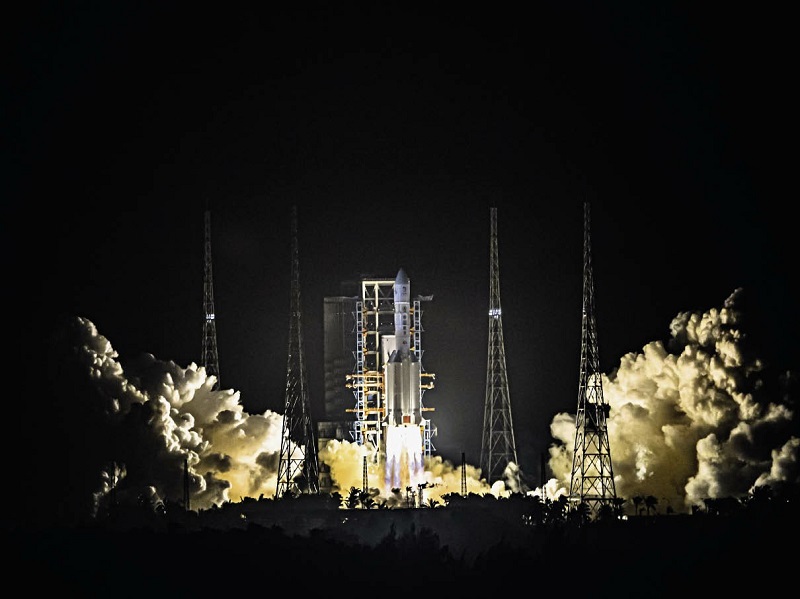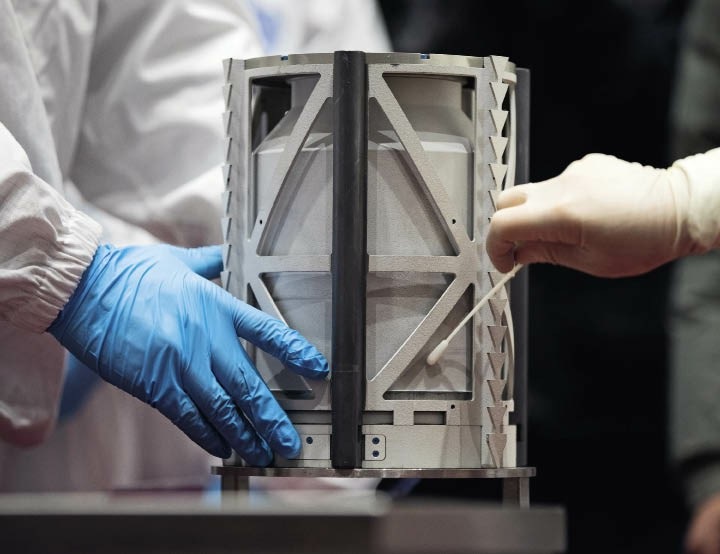Named after the Chinese mythical moon goddess, the Chang’e-5 robotic lunar probe was successfully launched from Wenchang Spacecraft Launch Site in Hainan Province on November 24, 2020. After more than 20 days in orbit, the probe brought back about 2 kilograms of lunar samples to Earth.
The expedition is a new milestone in the history of China’s space industry, marking that the world’s second largest economy now has the ability to travel between Earth and the moon. It also lays a solid foundation for the country’s future lunar and planetary explorations.

A Long March-5 rocket blasts off from China’s Wenchang Satellite Launch Center at 4:30 a.m. on November 24, 2020, to carry the Chang’e-5 probe to the Earth-moon transfer orbit.
Retrieving Lunar Samples
The Chang’e-5 probe, developed by the China Aerospace Science and Technology Corporation (CASC), is one of the most complex spacecraft systems China has developed so far. It consists of an orbiter, a returner, a lander, and an ascender, and has 15 sub-systems. Gathering samples from the moon and packing them in a vacuum container are the most impressive feats this mission accomplished.
The China Academy of Space Technology (CAST), a subsidiary of the CASC, is responsible for the R&D of the probe’s core technologies. Designers devised two types of tools to take samples from the surface of the moon. The probe has drills for coring samples and claws for grabbing them. With all the advanced equipment, the probe collected about 2 kilograms of lunar soil by deep drilling, shallow drilling, shoveling, digging, and clamping among other methods. The samples were then sealed in a vacuum container.
Experts from CAST say that the Chang’e-5 sample retrieval devices are a totally new kind of technology. Everything from the flight mission to the measurement and control, lighting conditions, power supply, and thermal control of the probe has been taken into consideration. Besides, while collecting lunar samples, the probe tackled various challenges including high temperatures on the moon’s surface, the limited time, and the complex procedures required.
Lunar Takeoff and Ascent
After completing its two-day mission on the surface of the moon, Chang’e-5 headed home. However, it is not easy to get home from the moon, which ushers in another first in China’s space history — a lunar takeoff and ascent.
There is no flat launch site on the lunar surface, let alone a mature launch tower. Therefore, the ascender could only be launched on the lander. However, it was very likely that the lander may land on slopes, bumps, or any other unfavorable terrain, only to make the takeoff more difficult. Besides, the whole takeoff process relies solely on the spacecraft itself.
In the face of such technical difficulties, experts from CAST conducted numerous ground tests. The simulation of the lunar surface environment featuring low gravity and high vacuum itself is no easy task.
After a series of technological breakthroughs, a research team at the CAST successfully carried out various tests and established a set of interlinked systems to support the return of Chang’e-5 from the moon.
Unmanned Rendezvous and

A researcher opens the hatch of the Chang’e-5 returner at the Fifth Academy of the China Aerospace Science and Technology Corporation (CASC) on December 17, 2020, to take out the container with lunar samples inside.
Docking in Lunar Orbit
After taking off from the lunar surface, the Chang’e-5 ascender flew into the lunar orbit, but to send lunar samples back to Earth on its own required extra steps. It also needed to rendezvous and dock with the orbiter-returner combination in the lunar orbit and hand over the samples to the returner for the rest of the journey.
Though China’s manned spacecraft had carried out several rendezvous and docking operations in low-Earth orbit, an unmanned rendezvous in the lunar orbit, around 380,000 kilometers away from Earth, is considerably more challenging.
The orbiter-returner combination gradually approached the ascender through long-range guidance and short-range autonomous control, and captured the ascender with holding claws. During the process, there were no satellite navigation signals, so it needed to be highly automated under various constraints, such as the detection and control of the probe, illumination conditions, attitude and orbit control system (AOCS), power supply, and thermal control. The high-precision sample transferred device posed another challenge that needed to be addressed.
From the ascender’s entry into the lunar orbit till samples were completely transferred, designers carefully planned a series of actions for Chang’e-5, such as rendezvous, docking, operation of the combination, and separation, so that Chang’e-5 could accurately complete the sample relay.
Bringing Back Samples at High Velocity
Normally, spacecraft in low-Earth orbit travel at the first cosmic speed, about 7.9 kilometers per second, when they re-enter the atmosphere. However, Chang’e-5 moved toward Earth at the second cosmic speed of 11.2 kilometers per second.
A speed difference of over 3 kilometers per second makes a huge difference in dynamics. There was a risk that the Chang’e-5 would rush forward too hard and crash into Earth, causing mission failure.
To solve potential problems, researchers for the first time proposed a semi-ballistic jump method. The returner first enters the atmosphere at high speed, then “jumps” with the lift provided by the atmosphere, and then re-enters the atmosphere and returns to Earth at the first cosmic speed.
In 2014, China launched the Chang’e-5 re-entry and return test flight vehicle, which simulated the whole process of Chang’e-5 flight to the moon, orbiting around the moon, and returning to Earth. The method proposed by researchers proved successful. China became the third country in the world capable of bringing back a spacecraft from the lunar orbit to Earth, after the United States and the former Soviet Union.
But there are small differences between the experiment and the mission. The re-entry and return vehicle of Chang’e-5 used the previous test flight vehicle, experts said. However, the weight of the sample container is uncertain, which may affect the returner’s performance, thus posing higher requirements upon the guidance, navigation, and control system of the returner.
Pei Zhaoyu, deputy director of the Lunar Exploration and Space Program Center at China National Space Administration (CNSA), said the Chang’e-5 launch means that China has for the first time carried out a complete lunar sample storage, analysis, and research process.
Exploring the Unknown
Since the launch mission was approved, the whole Chang’e-5 mission team has devoted 10 years of hardwork to launch the probe. With full devotion and great passion, through trial and error, they overcame all the challenges of the core technological difficulties and accomplished their mission.
The lunar takeoff, orbital rendezvous and docking, re-entry and return carried out by the Chang’e-5 mission laid a foundation for future manned return missions and manned moon landing missions, said Wu Yanhua, deputy administrator of CNSA and deputy commander of the lunar exploration program, at a press conference held by the State Council Information Office. “The aim of China’s manned lunar landing program is to perform scientific research and to explore the unknown,” Wu said.
According to Wu, the first mission of China’s planetary exploration program has been initiated, which is the mission to Mars — Tianwen-1. A trio of spacecraft, consisting of an orbiter, a lander, and a rover, was successfully launched from Wenchang on July 23, 2020 to Mars. The Tianwen-1 probe entered orbit around the Mars on February 10, 2021. It has flown 475 million km and was 192 million km from Earth when it reached the Mars orbit. It marks the first time that a Chinese spacecraft has orbited an extraterrestrial planet.
In addition, three planetary exploration missions have been planned — an asteroid exploration and sampling mission, a Mars sampling return mission, and a Jupiter orbit and trans-planetary mission.
As for future interplanetary exploration, Wu said, “My personal understanding is that it will mainly be about ‘surveying, construction, and utilization.’” He explained that one aim is to survey the environment of the moon and other planets, including the space environment, geological environment, and all kinds of radiation of human concern.
The second aim is to construct infrastructure. The Queqiao satellite as part of the Chang’e-4 mission can provide continuous communication between Earth and the moon. Permanent infrastructure for water and power supply will also be built.
The purpose of “utilization” is mainly related to whether extraterrestrial resources could be used and developed by human beings. “This is one of the main purposes of interplanetary exploration activities across the world,” Wu said.
According to the three-step plan of China’s manned space program, 2021 and 2022 will be a busy period. Wu said China has planned 11 launch missions for the two years. In specific, a space station core module, two test modules, four cargo spacecraft, and four manned spacecraft will be launched to China’s space station. A large number of in-orbit scientific experiments will then follow.
For space development, Wu stated that carrier rockets constitute a determining factor. After the consecutive successful launch of the existing rockets, especially the Long March-5 carrier rockets, China will improve its new non-toxic pollution-free rocket system to fulfill future space missions.
FU YIFEI is a reporter with Science and Technology Daily.